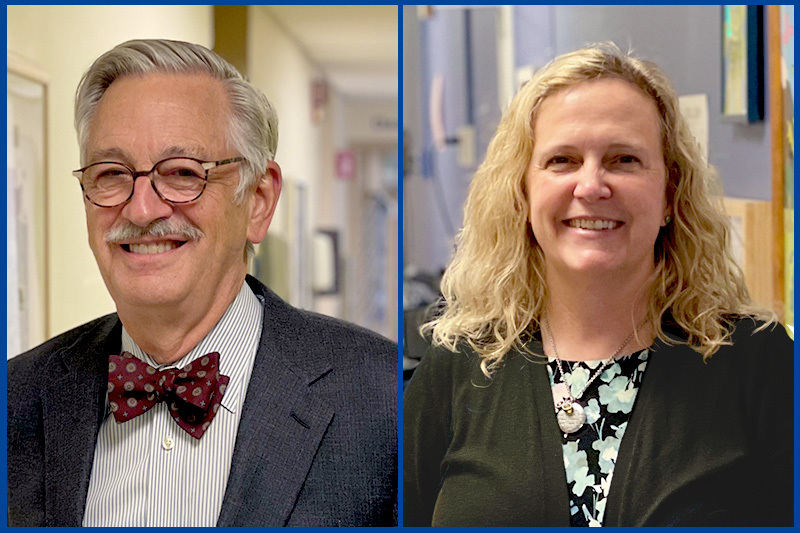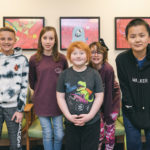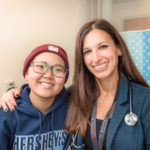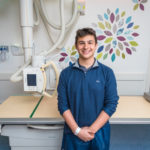Generations of excellence in caring for childhood bone cancers: Dr. Gebhardt and Dr. Anderson

When Dr. Mark Gebhardt was a surgical resident at Boston Children’s Hospital in the early ’80s, doctors were just starting to use chemotherapy to treat bone cancers like osteosarcoma and Ewing sarcoma. Boston Children’s and the Dana-Farber Cancer Institute were among the first places to offer this treatment. They were also among the first to offer limb-salvage surgery as an alternative to amputation.
Since then, Dr. Gebhardt has helped train a new generation of orthopedic oncology surgeons, including Dr. Megan Anderson, who now oversees orthopedic oncology at Boston Children’s.
Here, the two surgeons talk about why they’ve dedicated their careers to treating children and young adults with bone and soft tissue tumors, and how families can benefit from this team approach.
Why did you go into orthopedic oncology?
Dr. Gebhardt: Orthopedic oncology suits my temperament because it’s a “team sport.” Working with pediatric oncologists, radiation oncologists, radiologists, and pathologists, as well as the patient and their family, is part of what makes this work rewarding.
Dr. Anderson: I liked that none of the procedures are the same, that we take care of a range of age groups and operate on all sites in the body. I also really liked the science and medical side of it. We’re searching for answers to help figure out a patient’s diagnosis and formulate a plan of care.
How would you describe your philosophy of care?
Dr. Anderson: Patient-centered care is our primary goal. We work collaboratively with all of the teams involved in caring for our patients to ensure as much continuity as possible.
How do you teach medical students to help patients cope with a cancer diagnosis?
Dr. Gebhardt: By example, I hope. One of the most difficult things for a patient and family to hear is that a tumor is malignant. They don’t have cancer until you tell them they have cancer. It’s important to sit down with them and look them in the eye and explain the diagnosis while somehow giving them hope. You can’t promise the treatment will work, but you can promise that they’ve come to the right place and you’re never going to abandon them. It’s a difficult skill to teach. Some people get it easily, like Megan did, and others never do.
Why is this the right place for patients with bone cancer?
Dr. Gebhardt: We’ve been treating these diseases for a long time and have a rich history of caring for patients with challenging conditions. We have the combined expertise of Boston Children’s and Dana-Farber Cancer Institute. The teams here are made up of experienced people who are always available and never say no.
How would you describe your working relationship?
Dr. Anderson: Mark is the best person on the planet when a patient has a really tough diagnosis and I need someone to help me think through treatment options. He’s also teaching me how to be an effective leader as I take on more responsibility in the department.
Dr. Gebhardt: We have a strong friendship and respect for each other. This work is often very rewarding, but there are a lot of struggles along the way. We work well together on difficult cases while keeping our patients’ best interests at the front of our minds. Our personalities just sort of jive.
When you look ahead to the future, what excites you the most?
Dr. Anderson: The pandemic gave us a chance to step back and identify gaps in care for children with rare diseases. Children who live near (or can travel to) a center like Dana-Farber/Boston Children’s Cancer and Blood Disorders Center have access to a different level of care than those who don’t or can’t. We shouldn’t accept variations in care when getting patients to a center that specializes in their disease is simply a matter of logistics. In addition to caring for patients at Boston Children’s, I serve on a number of national boards and look forward to addressing issues like this on that level.
Dr. Gebhardt: One of the joys of being a teacher is watching your students grow and excel in ways you never could have imagined. That’s certainly what has happened with Megan. And while Dr. Carrie Heincelman, who joined our team in 2019, is at an earlier stage in her career, she’s doing the same thing. I’m looking forward to seeing both of them continue to improve care for patients with bone and soft tissue tumors.
Learn more about the Bone and Soft Tissue Tumors Program and the Dana-Farber/Boston Children’s Cancer and Blood Disorders Center.
Related Posts :
-

Bone cancer surgery: A difficult choice
Nolan and Natasha might never have met if they hadn’t been diagnosed with bone cancer. Nolan, 13, is a natural ...
-

Osteosarcoma patient gets chance to be a 'normal college kid'
For almost half of his life, Michael Murray has had to grapple with cancer, including multiple relapses. One of his ...
-

Kaitlyn begins road to recovery after foot amputation
At just 14 years old, Kaitlyn Vu was asked to accept a drastic, life-altering surgery. In early 2019, she was diagnosed with&...
-

Limb-salvage surgery is best option for Andrew
It was quite a spring for Andrew Hedberg. The rising high school sophomore made the varsity golf team and was ...





